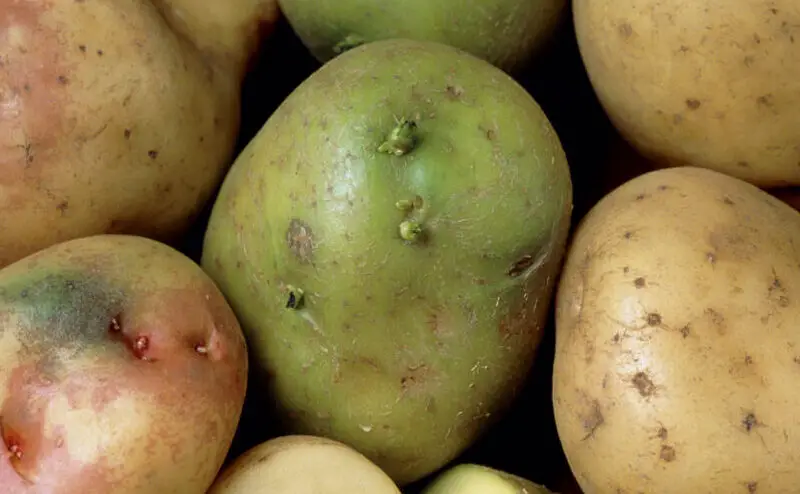When you catch a bag of potatoes and see that they have started to turn green, you are faced with a puzzle of whether to throw them away.
Some people reduce their losses and throw the green potatoes away, while others remove the green spots and use them anyway. When potatoes are exposed to light, they produce chlorophyll, a pigment that gives them a green color. Chlorophyll itself is completely harmless, but it can signal the presence of a toxin.
Contents
Can we plant green potatoes?
If the green part of a potato is toxic for consumption, it does not prevent the making of seedlings. So there is no problem to replant green potatoes.
If you plan to compost your old potatoes, it would be safer to mix them with grass clippings so that they undergo hot composting which destroys the fungi.
Why does the potato turn green?
The potato turns green when it is too widely exposed to light or even direct sunlight. This exposure can take place just after the tubers are harvested, as it is advisable to let them air dry before storage, but also after purchase, if the correct potato storage principles are not followed.
The greening of the potato is therefore due to the production of chlorophyll, which promotes the concentration of solanine (a glycoalkaloid). The latter makes the potato unfit for consumption as it can lead to varying degrees of health problems.
Can we eat a green potato?
Peeling potatoes removes much of the solanine, which is mainly contained in the skin. Cooking, on the other hand, does not change the level of solanine.
If your potatoes have some green areas, peel them a little deeper where the skin has turned green. If they are almost completely green, it is best to discard them (or compost them), as solanine is potentially present in significant amounts not only in the skin but also in the flesh.
Is peeling or cooking green potatoes enough to remove toxins?
Solanine levels are highest in the skin of a potato. For this reason, peeling a green potato will help to significantly reduce its levels.
Studies have estimated that peeling a potato at home removes at least 30% of its toxic plant compounds. However, up to 70% of the compounds still remain in the flesh.
This means that in potatoes with a very high concentration of solanine, the peeled potato may still contain enough to make you sick.
Unfortunately, boiling and other cooking methods, such as baking, microwaving or frying, do not significantly reduce solanine levels. Thus, they will not make green potatoes any safer.
If a potato has only a few small green spots, you can cut or peel them. Since solanine is also produced at higher concentrations around the eyes, or shoots, of a potato, they should be removed as well.
However, if the potato is very green or has a bitter taste (a sign of solanine), it is best to discard it.
How to prevent potatoes from turning green
Fortunately, cases of solanine intoxication are rare. However, it may be under-reported due to the generic nature of its symptoms.
Potatoes that contain unacceptable levels of solanine do not usually make it to the grocery store. However, if not handled properly, potatoes can produce solanine after delivery to a supermarket or during storage in your kitchen.
Therefore, proper storage of potatoes is important to prevent the development of higher levels of solanine. Physical damage, exposure to light and high or low temperatures are the main factors that cause potatoes to produce solanine. Be sure to inspect the potatoes before you buy them to make sure they have not been damaged or have already begun to green up.
At home, store them in a cool, dark place, such as a root cellar or basement. They should be kept in an opaque bag or plastic bag to protect them from light. Keeping them in the refrigerator is not ideal because it is too cold to store potatoes. Some studies have even shown an increase in solanine levels due to storage at refrigerator temperature.
In addition, the average kitchen or pantry is too hot for long-term storage. If you don’t have enough room to store your potatoes, buy only the amount you plan to use. Store them in an opaque bag on the back of a cupboard or drawer where they will be better protected from light and heat.
Summary
Green potatoes should be taken seriously. Although the green color itself is not harmful, it can indicate the presence of a toxin called solanine.
Peeling green potatoes can help reduce solanine levels, but once the potato has turned green, it is best to discard it.









